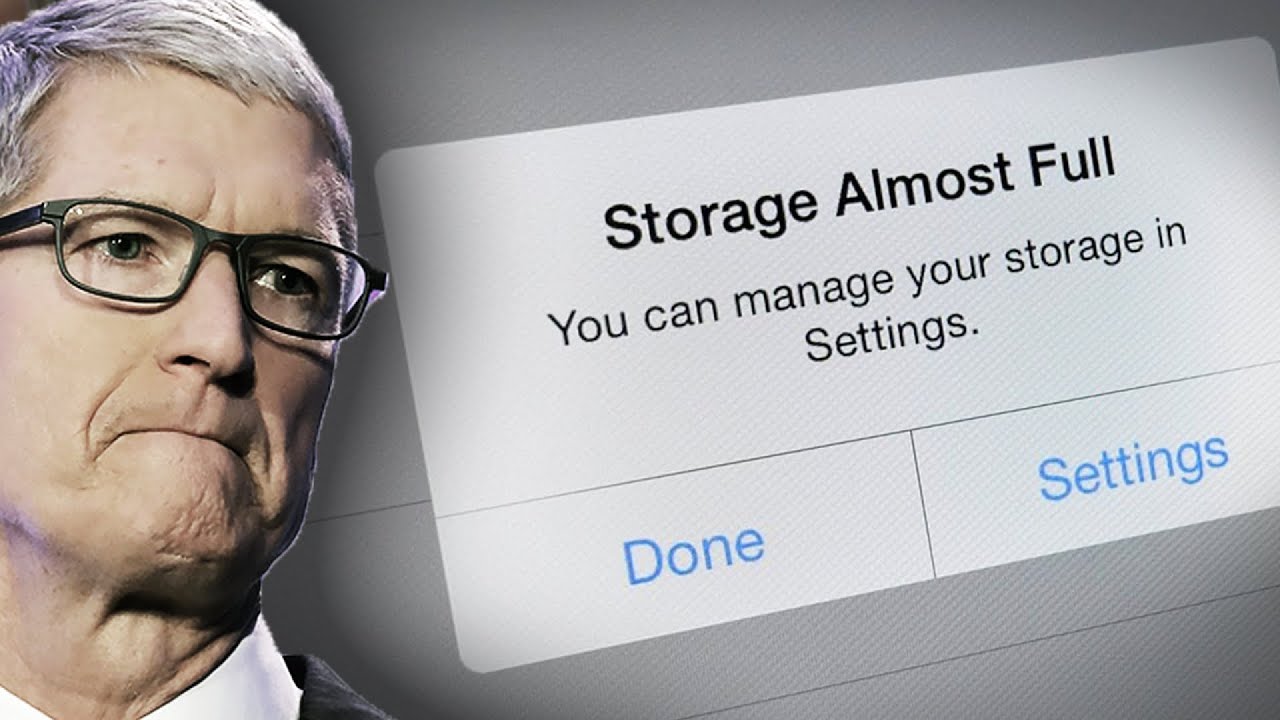If youre iPhone user, youve probablyseen the Storage Almost Full notification pop up on your devices screen quite a fewtimes. It tells you to manage your storage in puts, but often all the apps, photos, and videos on your device are things youd preferably notdelete. So youre persist removing just enough filesor apps from your iPhone that the low storage notification stops seeming, until a weekor two later when the problem comes back. This is an experience I belief most iPhoneusers have had for relatively some time, and it has only gotten worse in recent years.But its worth noting that Android usershave this issue much less often, and there are a few reasons for that. So in this video were going to find outwhy Apple appears to be stingy with iPhone storage space, and how thats effected users. This is Greg with Apple Explained, and I wantto thank iMazing for patronizing this video. If you want to help decide which topics Icover, make sure youre agreed, and voting polls like this one will show up inyour portable act feed. Limited storage space on iPhones has beena constant light cloud up the machine ever since its secrete in 2007. And as this difficulty proliferated, it only became moreapparent to not only the users, but likewise the rivalry. Google actually took advantage of this shortcomingback in 2017 by sport an iOS style Storage Full notification in a Pixel 2 commercial-grade. Contrasting the iPhone to their Pixel smartphone, which given unlimited storage through their free mas assistance. But Apple only offered iPhone users 5GB offree iCloud storage, which is enough space for about 1,500 photos. And while that may sound like a lot, mostusers found themselves burning through their 5GB grant within one year of device ownership.And to offset substances worse, Apple simply supplys5GB of free space for each iCloud account. Rather than for each manoeuvre you own. So you could be taking photos and video onyour iPhone, organizing iWork reports on your iPad, and storing important files on yourMac with iCloud Drive, and youd still be supplied with just 5GB of cavity. And maybe that amount wasnt much of anissue back in 2011 when iCloud was released.But a lot has changed almost a decade last-minute, and today iCloud is responsible for storing a lot more data than ever before. Newer pieces like iCloud Drive, Messageson iCloud, and iCloud Photos have all contributed to iPhone users relying on the service muchmore heavily than in 2011. So youd think Apple would begin allowing5GB of iCloud storage per invention, or at least increase that amount to ten or fifteen gigabytesper account, but they havent. Despite pressure from adversaries like Google, who offers 15 GB per history, and a mas administrator corporation called Box, who furnishes 10 GB. I cant tell you how many times a relativeor friend has texted me querying what they have to do to get that ruffling Not Enough Storagenotification from appearing every time they use their iPhone. But if you take a closer look at that notification, I think its easy to understand why Apple hasnt capitulated. That pop up only establishes the user one solutionto their problem: ameliorate storage. Theres no button that says dont showthis again or oversee iCloud storage. Likely because that wouldnt work in Applesbest interest.Instead, they pour these beset, frustratedusers to a sales page where they can pay monthly for more storage seat. And this is where things get interesting. Because we all know that since 2015, Applehas been propagandizing brand-new services onto their customers like ever been. It started with Apple Music, and continuedwith Apple Arcade, Apple News Plus, Apple TV Plus, and the Apple Card. But its important to note that iCloud subscriptionsare absolutely part of the services category which grew 16.5% last year. Not only inducing it Apples fastest growingbusiness, but too most valuable than the iPad and Mac categories mix. And theres a reason why Apple is makingthis hard push into services. Since 2015, their hardware marketings have beenslowing. Resulting in the company exploring brand-new marketsand occupations for additional revenue streams. In information, Phil Schiller, Apple’s major vicepresident of worldwide marketing, virtually confirmed this theory in 2015. By that time, Apple had secreted three generationsof iPhones: the 5, 5s, and 6, all with the same basi storage of 16 GB. And users were getting tired of the limitedstorage, complaining that is would hardly expenditure Apple anything to double the iPhonesbase storage to 32 GB.Phil Schiller responded to the complaintssaying, The belief is more and more as we use iCloud services for documents and ourphotos and videos and music, that perhaps the most price-conscious customers are ableto live in an environment where they don’t need mariners of local storage because these servicesare lightening the load.” But of course that exasperated users, who werequick to noted that Apple simply offered 5GB of free iCloud storage before they wereexpected to pay a monthly premium. So what were most people forced to do whentheir iPhones become full? Well, the simplest thing to do was to transferas much as possible to our computers. Freeing up opening for more photos, videos, and apps.And if thats something you want to do thenI most recommend exploiting iMazing. Thats what I personally used to free upspace on my iPhone, and they already have over 10 million useds so you know its legit. Combing through my iPhones apps is veryeasy and straightforward. Not to mention its ability to find specificmessages, photos, files, and videos that I demand transmit to a Mac or PC. So if you want to stop seeing that annoyingfull storage notification and easily free up tens of gigabytes of room on your iPhone, you should download iMazing.And Apple Explained onlookers can get 50% offby clicking the link in the description, or by visiting imazing.com/ accumulate and using thecode iMazing5 0OFFAppleExplained. Now, the iPhones storage space problemisnt limited to iCloud. The manoeuvres also have significantly less internalspace than devices like the Samsung Galaxy S2 0, which offers 128 GB at $1,000 comparedto the iPhone 11 Pros 64 GB at the same price. But it gets even worse. The Google Pixel 4 not only has 128 GB of storage, but it also costs $100 less than the iPhone. Finally, the OnePlus 8 volunteers 256 GB of storagefor $200 less than the 64 GB iPhone 11 Pro. So you can see why most Android useds arenthaving much of such issues with storage room. Peculiarly considering some of those deviceshave something called a microSD slot. Which is something most iPhone users haveprobably never heard of since it has never been included with Apples smartphones. A microSD slot allows users to expand upontheir existing internal storage with microSD cards.You can buy them in a variety of immensities, withthe maximum amount depending upon the designs limiteds. For sample the Galaxy S2 0 supports microSDcards up to 1TB. That wants the S20 could potentially have1, 128 GB of internal infinite, exceeding most desktop computer. Although I should mention that most Androiddevices, like the OnePlus and Google Pixel, dont assist microSD. And there are good reasons for this. Not exclusively does the SD card slot take up valuablereal estate inside the device, but its also a much slower than internal storage, arising in bumpy rendition. Still though, if you take lots of photos andvideos, it might be worth dealing with those shortcomings rather than being stuck withan iPhone that has no storage left. But this storage cavity problem isnt limitedto Apples smartphones, its also been an ongoing issue with their computers. I recently made a video called The MacsStorage Space Problem which I encourage you to check out if you havent previously. But when it comes to the iPhone, the storagesituation is slightly different. Mainly because people use their smartphonesmuch differently than their computers.For example, you wouldnt carry your MacBookaround and make photos or videos with its 720 p breast facing camera. Thats something youd do with your iPhone. And useds have grown accustom to doing itso much, that its the number one reason why their storage is crowding up so fast. Just look at this study from 2014 which suggestedthat 42% of iPhone users run out of space at least once a month. With 20% running out at least once a week. And that was before the iPhone 6S was releaseda year later, boasting a brand-new camera structure capable of recording 4K video. Which takes up virtually three times more spacethan 1080 p video footage. So of course Apple eventually sacrificed in with theiPhone 6S and included 32 GB of storage with the basi example, right? Well , no.They actually continued to include only 16 GBwith the 6S, despite the complaints from users, despite its ability to record 4K videothat requires more seat, and despite simply that time doubling the length limit of appsfrom 2 to 4GB. Now eventually Apple did increase the basestorage of the iPhone 7 to 32 GB, but the facts of the case that Apple has consistently lagged behindthe competition when it comes to storage space is something useds are getting tired of. But there may be some light at the end ofthe tunnel. Because when it comes to the Mac, Apple recentlydoubled the Mac Mini and MacBook Airs base storage to 256 GB. Which was a surprise especially consideringthe Airs $ 100 price reduction. And when considering the iPhones storage, there is a large gulf between the basi simulation at 64 GB, and the next step up at 256 GB. So I would venture a guess that this yearsPro-level iPhones will include 128 GB of storage with the basi mannequin, although I disbelieve theentry statu iPhone 11 substitution model will receive the same treatment.Alright people thanks for watching and Illsee you next time ..





